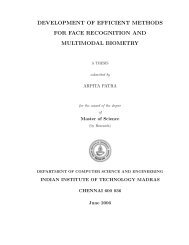The Enigma of Group Theory - Department of Computer Science ...
The Enigma of Group Theory - Department of Computer Science ...
The Enigma of Group Theory - Department of Computer Science ...
You also want an ePaper? Increase the reach of your titles
YUMPU automatically turns print PDFs into web optimized ePapers that Google loves.
http://www.cs.bris.ac.uk University <strong>of</strong> Bristol, <strong>Department</strong> <strong>of</strong> <strong>Computer</strong> <strong>Science</strong><br />
THE ENIGMA OF GROUP THEORY<br />
With the advent <strong>of</strong> the 1920s people saw the need for a mechanical encryption device. Taking a substitution<br />
cipher and then rotating it became seen as the ideal solution. This idea had actually been<br />
used previously in a number <strong>of</strong> manual ciphers, but using machines it was seen how this could be<br />
done more efficiently. <strong>The</strong> rotors could be implemented using wires and then encryption could be done<br />
mechanically using an electrical circuit. By rotating the rotor we obtain a new substitution cipher.<br />
As an example, suppose the rotor used to produce the substitutions is given by<br />
ABCDEFGHIJKLMNOPQRSTUVWXYZ<br />
TMKGOYDSIPELUAVCRJWXZNHBQF<br />
By this we mean that the plaintext letter A will encrypt to the ciphertext letter T, and so on. In the past a<br />
substitution cipher was only used on its own, thus the word EGG would encrypt to the word ODD. This<br />
turns out not to be a good idea because the plaintext letter, e.g. G, always encrypts to the same ciphertext<br />
letter, e.g. D. This fact allows a cipher based solely on a single substitution, a so-called substitution cipher,<br />
to be easily broken [8].<br />
A simple way <strong>of</strong> increasing the security <strong>of</strong> a substitution cipher is to rotate the ciphertext alphabet<br />
by one letter every time we encrypt. So to encrypt the first letter we use the substitutions given by<br />
ABCDEFGHIJKLMNOPQRSTUVWXYZ<br />
TMKGOYDSIPELUAVCRJWXZNHBQF<br />
However, to encrypt the second letter we rotate the rotor by one position and use the substitutions<br />
To encrypt the third letter we use the substitutions<br />
ABCDEFGHIJKLMNOPQRSTUVWXYZ<br />
MKGOYDSIPELUAVCRJWXZNHBQFT<br />
ABCDEFGHIJKLMNOPQRSTUVWXYZ<br />
KGOYDSIPELUAVCRJWXZNHBQFTM<br />
and so on. This the word EGG will become encrypted to ODS. This gives us a polyalphabetic substitution<br />
cipher with 26 alphabets.<br />
<strong>The</strong> most famous <strong>of</strong> the rotor machines developed in the first half <strong>of</strong> the twentieth century was the<br />
<strong>Enigma</strong> machine used by the Germans in World War II [2]. We shall describe the most simple version <strong>of</strong><br />
<strong>Enigma</strong> which only used three such rotors, chosen from the following set <strong>of</strong> five.<br />
ABCDEFGHIJKLMNOPQRSTUVWXYZ<br />
EKMFLGDQVZNTOWYHXUSPAIBRCJ<br />
AJDKSIRUXBLHWTMCQGZNPYFVOE<br />
BDFHJLCPRTXVZNYEIWGAKMUSQO<br />
ESOVPZJAYQUIRHXLNFTGKDCMWB<br />
VZBRGITYUPSDNHLXAWMJQOFECK<br />
3










